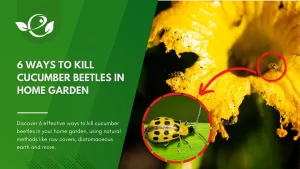Table of Contents
If you’re a proud lawn owner, nothing is more frustrating than waking up to a yard dotted with unsightly mounds of soil. These are ant hills — the visible signs of colonies growing beneath the surface. While ants are fascinating insects that contribute to ecosystems, they’re less welcome when they take over your outdoor spaces. In this in-depth guide, we’ll explore effective natural and chemical methods to get rid of ant hills in your yard and keep them from coming back.
What Are Ant Hills and Why Do They Appear in Your Yard?
Ant hills are conical mounds of soil formed by ants as they excavate underground tunnels for their colonies. Contrary to what many believe, the hill is not the actual nest but rather the displaced dirt from below. These structures serve as ventilation points and protective covers for the colony’s internal labyrinth.
Several factors attract ants to your yard:
- Soil condition: Loose, well-aerated soil makes it easy for ants to dig.
- Moisture levels: Ants thrive in areas with consistent moisture.
- Availability of food: Leftover pet food, sugary spills, and even other insects draw ants.
- Lack of disturbance: Lawns or garden beds that are seldom tilled or walked on create the perfect breeding ground.

The most common culprits behind ant hills include fire ants, pavement ants, and field ants. Each has a different level of aggressiveness and damage potential, but all can become problematic if left unchecked.
How to Get Rid of Ant Hills in Your Yard
When it comes to eliminating ant hills, you have two main options: natural solutions or chemical treatments. Each has pros and cons, and the right choice depends on your yard size, the severity of the infestation, and whether you prefer eco-friendly methods.
1. Pouring Boiling Water
Boiling water can kill ants on contact and collapse the tunnels they’ve built underground. It’s a quick method that targets the colony head-on.
Steps:
- Boil 1–2 gallons of water.
- Slowly pour directly over the center of the ant hill.
- Repeat once daily for 2–3 days if the hill reappears.
Tips:
- Use caution to avoid scalding nearby grass or plants.
- Wear gloves and closed-toe shoes during application.

2. Vinegar Solution
The acetic acid in vinegar disrupts ants’ pheromone trails and kills them. It’s especially useful for small hills or early infestations.
Steps:
- Mix equal parts white vinegar and water in a spray bottle or bucket.
- Saturate the mound and immediate surroundings.
- Apply in the early morning or evening when ants are less active.
Note: Vinegar has a strong odor that fades after a few hours but may deter pets temporarily.

3. Diatomaceous Earth (DE)
Diatomaceous earth is a fine powder made from crushed fossilized algae. It causes micro-cuts on ants’ bodies, dehydrating them slowly but effectively.
Steps:
- Use only food-grade DE.
- Lightly dust the hill and a 1-foot radius around it.
- Reapply after rain or heavy dew.
Advantages: Safe around pets and kids when kept dry. Works well in combination with other remedies.
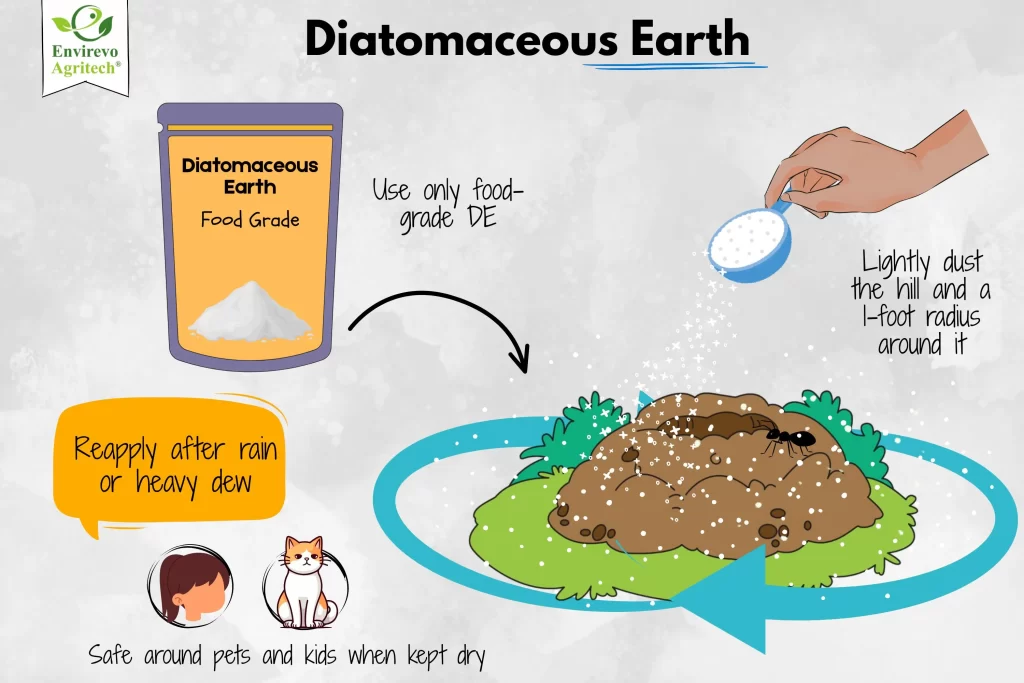
4. Flooding the Hill
To eliminate ants, thoroughly saturate the ant hill and surrounding soil with a high-pressure stream of water for at least 3-5 minutes, ensuring the ground is completely soaked and water pools on the surface.
Steps:
- Use a hose on full pressure.
- Saturate the mound for at least 3-5 minutes.
- Add dish soap to the water for greater effect.
- Monitor the area for ant activity 2-3 times daily over the next three days. If no activity is observed after this period, the ants are likely eradicated.
- If ants persist, repeat the flooding process or consider alternative methods.
Caution: May not kill the queen unless combined with soapy water or other solutions.
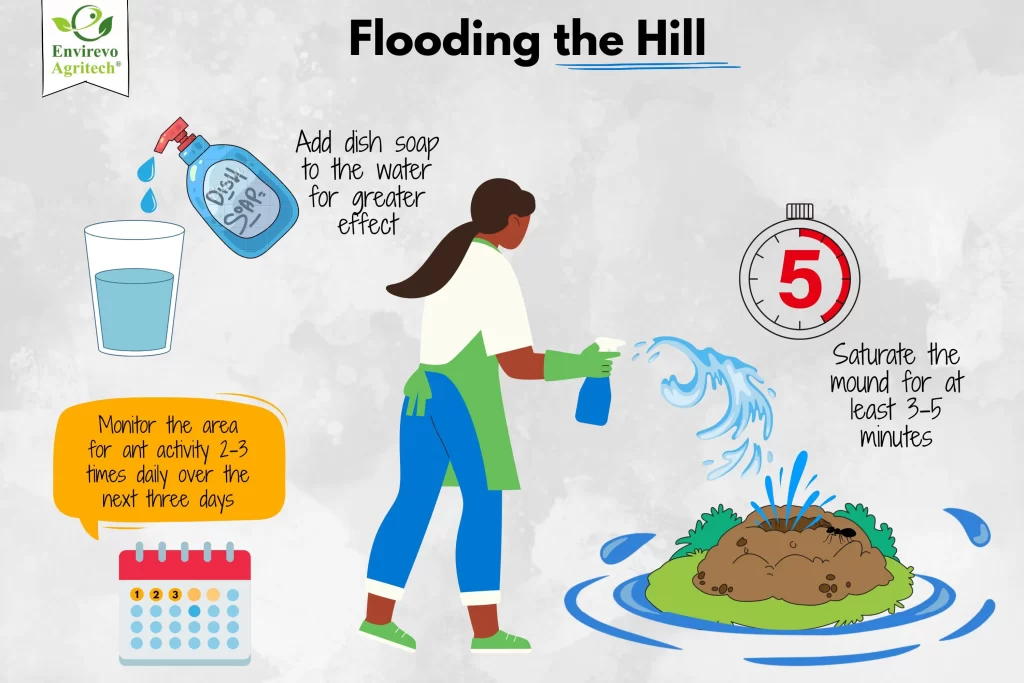
Related: How To Get Rid Of Moles In Your Lawn: Best ways To Stop Moles
5. Soapy Water
If regular water doesn’t do the trick, mix in some soap. Any type of soap will work. Soap breaks down ants’ exoskeletons and suffocates them. It’s effective and gentle on most lawns.
Steps:
- Mix 1 tablespoon of dish soap with 1 quart of water.
- Slowly pour 2–3 US gal of soapy water into the ant hill.
- Pour directly into the mound.
- For larger hills, increase the quantity accordingly.
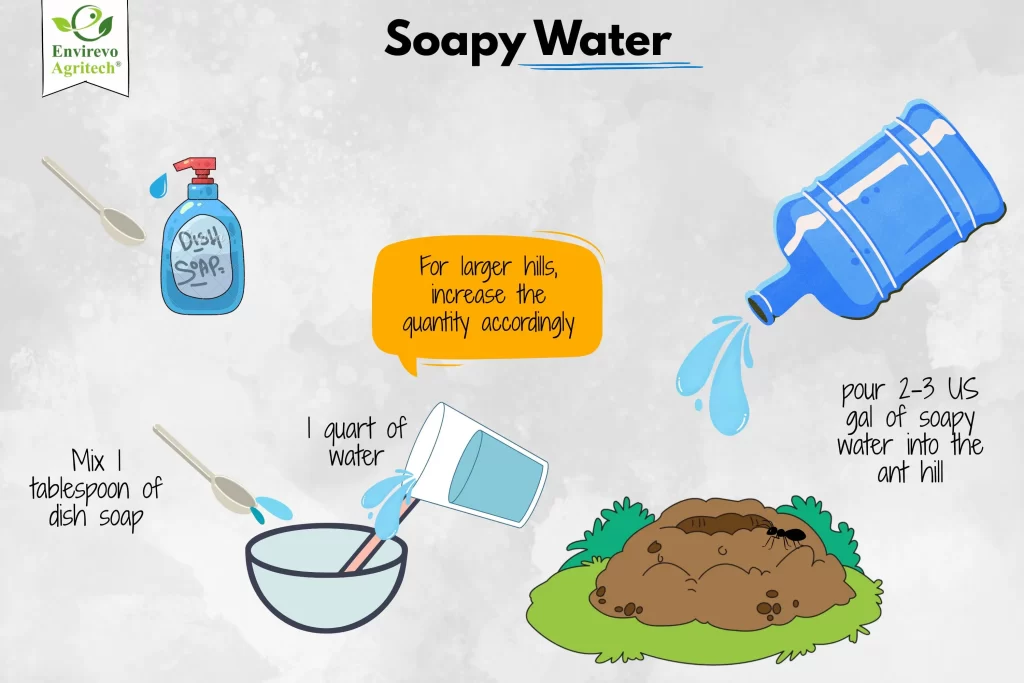
6. Cornmeal or Baking Soda Bait
These ingredients work slowly and are more preventative than curative. Baking soda is often mixed with powdered sugar, attracting ants who then ingest the mixture.
Steps:
- Mix baking soda and powdered sugar 1:1.
- Sprinkle around the mound and trails.
Cornmeal may cause ants to starve after eating, though its effectiveness is debated.
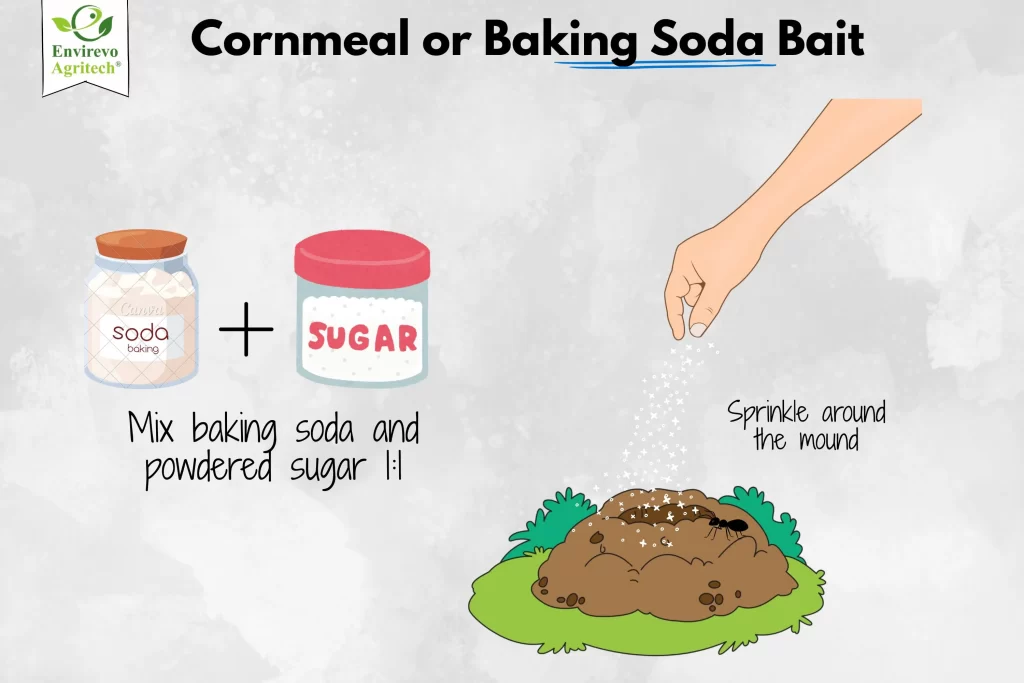
Related: How to Get Rid of Crayfish in Your Lawn: Best Control Methods
7. Orange Rind Smoothie
Citrus oils contain natural insecticides. Orange rinds are rich in d-limonene, a natural insecticidal compound that disrupts the respiratory systems of ants. When prepared as a slurry or “smoothie,” this mixture not only kills ants but also masks their pheromone trails, deterring future infestations.
Steps:
- Collect fresh orange peels (you can also use lemon or grapefruit peels).
- Add the rinds to a blender with just enough warm water to form a thick slurry.
- Optional: Add a tablespoon of white vinegar or a drop of dish soap for added potency.
- Pour the mixture directly into the center of the ant hill and around its base.
- Repeat every few days until you see a reduction in activity.
Bonus: It smells pleasant and enriches the soil.

8. Ant Killers and Insecticide Dusts
These treatments contain active ingredients like bifenthrin, permethrin, or deltamethrin. They kill ants on contact and often linger in the soil to prevent re-infestation.
Steps:
- Apply according to package directions.
- Sprinkle dust or spray liquid around and on the mound.
- Avoid disturbing the hill before application to ensure ants are present.
Tips:
- Choose products labeled “colony control” or “kills queen.”
- Wear gloves and mask when applying.

9. Granular Ant Baits
Baits allow worker ants to carry poison back to the colony, where it kills others — including the queen. This is one of the most effective long-term strategies.
Steps:
- Spread bait 1–2 feet from the mound entrance.
- Do not place directly on top — ants may avoid it.
- Reapply every two weeks or after rain.
Recommended Brands: Amdro, Terro, Spectracide.
Advantages: Eliminates the colony over time and is easy to apply.

10. Boric Acid Bait
Boric acid is a slow-acting poison that ants ingest and bring back to the nest.
DIY Recipe:
- Mix ½ tsp boric acid, 8 tsp sugar, and 1 cup warm water.
- Soak cotton balls or paper towels in the solution.
- Place near the hill and ant trails.
Caution: Keep away from pets and children. This bait is highly effective but slow-acting (5–7 days).
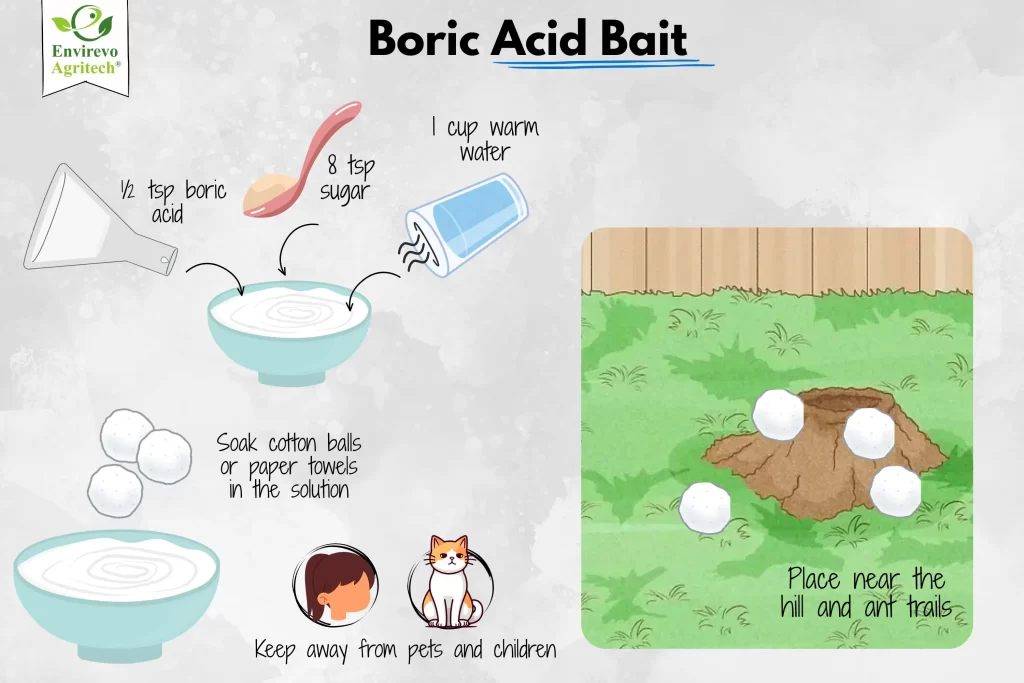
11. Commercial Ant Sprays
Sprays such as Raid or Ortho Home Defense offer immediate knock-down action.
Use For:
- Spot treatment on visible trails or entry points.
- Quick action while other long-term methods work.
Note: Not effective for full colony elimination unless paired with bait.
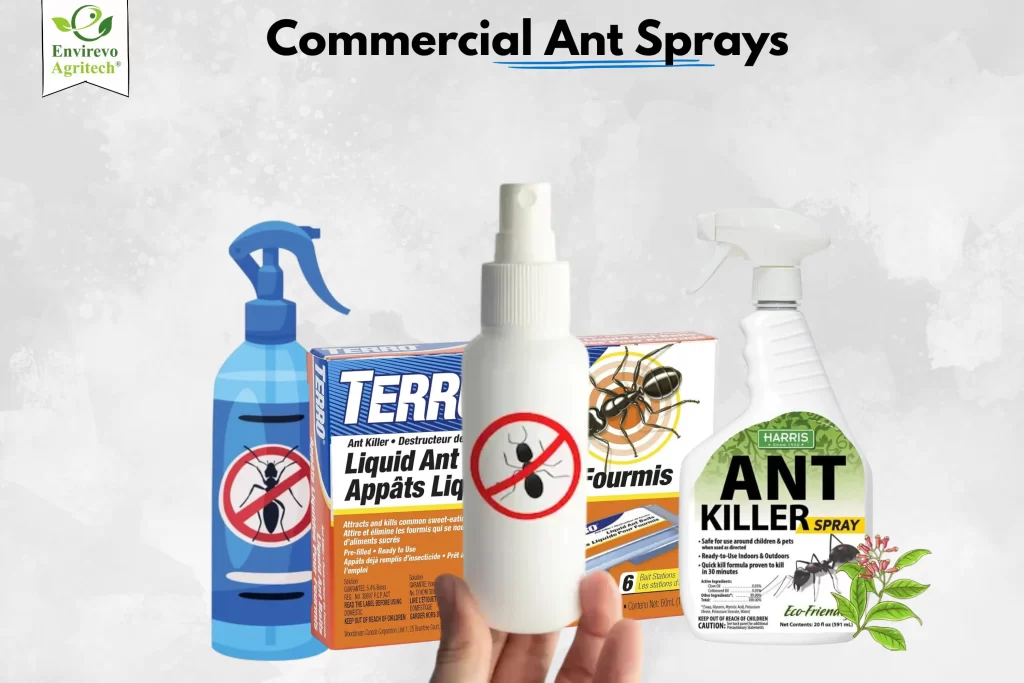
When to Call a Professional Pest Control Service
DIY methods are great for minor to moderate infestations, but sometimes professional intervention is the only solution.
Signs You Need a Pro:
- Ant hills return within days of treatment.
- Multiple large colonies are present.
- Ants begin entering your home.
- You’re dealing with aggressive stinging species like fire ants.
What to Expect:
- Professional-grade insecticides and baiting systems.
- Colony tracking and targeted elimination.
- Ongoing monitoring and preventive measures.
While it may be more costly, hiring experts ensures thorough and long-lasting control, especially in heavily infested or sensitive areas.
FAQs About Getting Rid of Ant Hills
Will mowing destroy an ant hill?
Not completely. It might level the mound but won’t affect the colony underground.
Can ants kill grass?
Yes. Ants disrupt the soil and root systems, leading to dead patches.
How long does it take to kill an ant colony?
It can take anywhere from a few days to a few weeks, depending on the method and colony size.
What kind of ants build ant hills?
Fire ants, field ants, and some pavement ants are common mound-builders.
Can you kill ant hills with bleach?
Yes, but it’s not recommended. Bleach harms soil and plants and doesn’t always reach the queen.
What is the fastest way to kill an ant colony?
Boiling water or professional-grade insecticides offer the quickest results.
Final Thoughts
Ant hills are more than just an eyesore — they can wreak havoc on your lawn, pose safety risks, and serve as a gateway to indoor invasions. Thankfully, whether you prefer eco-friendly methods like diatomaceous earth or faster chemical solutions such as insecticidal dusts and baits, there’s a strategy to fit every homeowner’s needs.
The key to success lies in acting early, choosing the right treatment for your yard, and maintaining your lawn regularly to discourage future colonies. With consistent effort and the right tools, you can get rid of ant hills and reclaim your yard once and for all.



